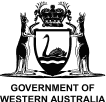Westport has partnered with the Western Australian Marine Science Institution (WAMSI) to deliver the $13.5 million WAMSI-Westport Marine Science Program. This 3-year program is developing the latest data, information and modelling on the complex environmental systems and community values associated with Cockburn Sound.
Project 8.2: Australian sea lion abundance and movement in the Perth metropolitan area
Research theme: Apex Predators and Iconic Species
Researchers: C Salgado Kent (Edith Cowan University), K Waples, S Parsons, H Raudino, A Sequeira, J Edwards (Department of Biodiversity, Conservation and Attractions), A Sequeira (Australian National University), S Vitali (Zoo and Wildlife Veterinary Services WA), B Gardner (Werribee Open Range Zoo)
Publication date: August 2024
Understanding the abundance, movement and habitat use of sea lions in Perth metropolitan area:
In Western Australia, the Australian sea lions can be found along our southern coast, and within the Perth coastal waters.
As mammals, they spend much of their time at sea, foraging for food, resting at ‘haul-outs’ like Carnac or Seal Island. During breeding season, the male sea lions head north to meet the females on the islands in the Jurien Bay Marine Park.
As wild animals, calculating the population has some challenges.
Given female sea lions stay close to breeding grounds, and juveniles are more sensitive to human contact, this research focused on tagging male sea lions only during non-breeding season, when they are on the move and foraging, providing an indication of their distribution and preferred habitats.
A marking and ‘re-sight’ program, where seals were dabbed with black hair dye applied via sponge-covered aluminium numbers attached to an extendable pole, as well as satellite telemetry tags were used during the study.
A total of 49 sea lions were marked between September and mid-November 2022, with 12 resight surveys undertaken in the following period, before the marks faded or the sea lions moulted. Satellite tags were attached to 15 individuals within the same period.
What the report found:
- Male sea lion numbers ranged from 83 to 122 during the seasonal peak in the Perth coastal waters, most being part of the population that breeds in the Jurien Bay Marine Park. This number does not include females which stay near breeding grounds, or juveniles, so the actual numbers are likely higher.
- Tags lasted from 1 to 63 days and sea lions were tracked ranging as far north as Jurien Bay and as far south as Cape Naturaliste (both >200 km away). However, most sea lions spent the majority of their time in the Perth Metropolitan area resting on the haul-out islands between relatively short periods at sea.
- Sea lions regularly move between haul-out islands, coastal areas and open water, with visits made to Mandurah (Comet Bay and the inlet Collins Pool), Preston Beach, and Bunbury (Koombana Bay).
- Although there was variation between tagged individuals to the locations where they dived deep, when foraging, individuals showed preferences to specific areas, revisiting locations they had previously visited.
- Cockburn Sound was not identified as a key location among the sea lions that were tagged in this research program, however others were seen foraging in the Sound during the research program.
How Westport will use the report:
This study has given us a stronger insight into the population and habits of Australian sea lions in the Perth coastal area, providing a new benchmark for further studies and environmental management programs.
You can read the full report here.





